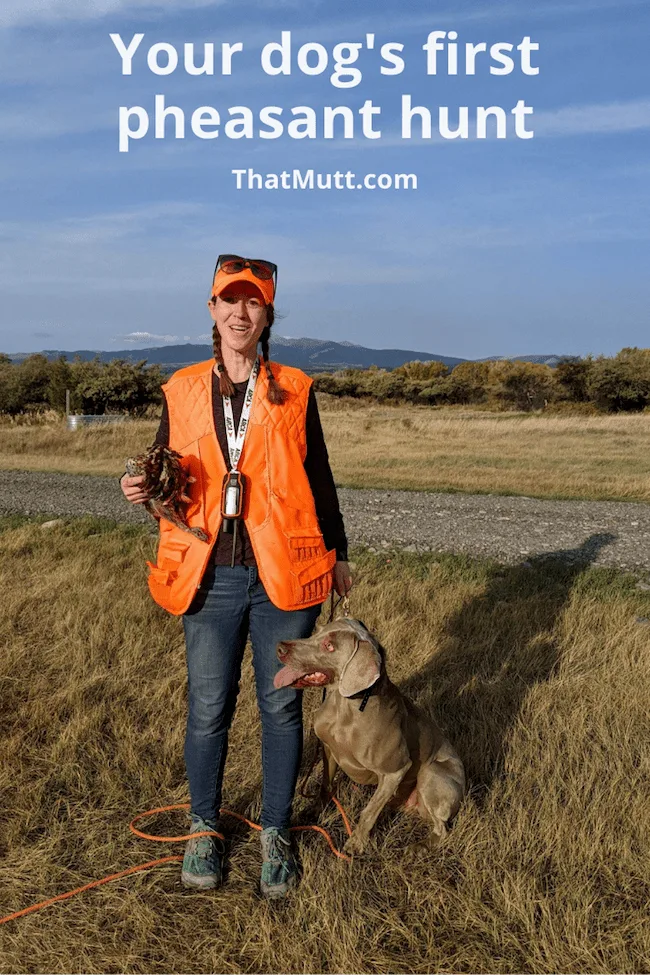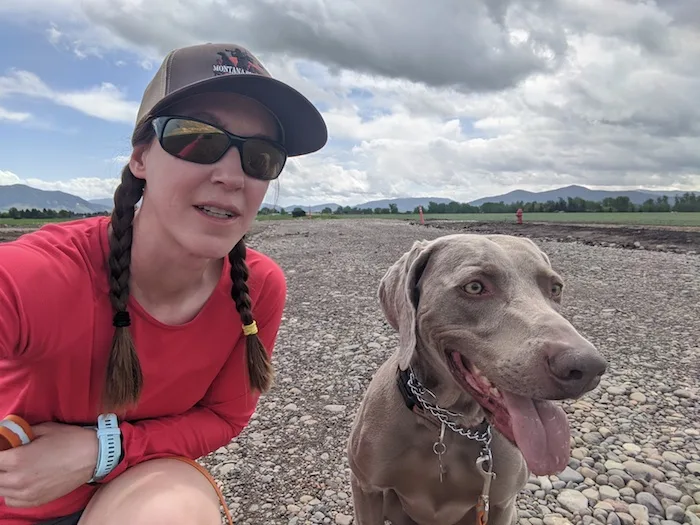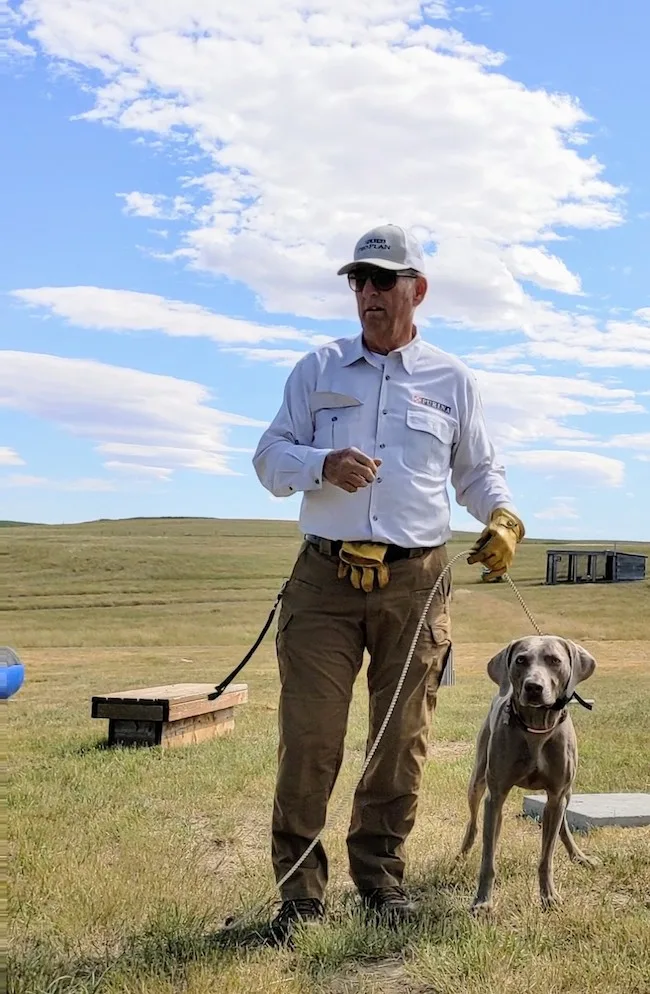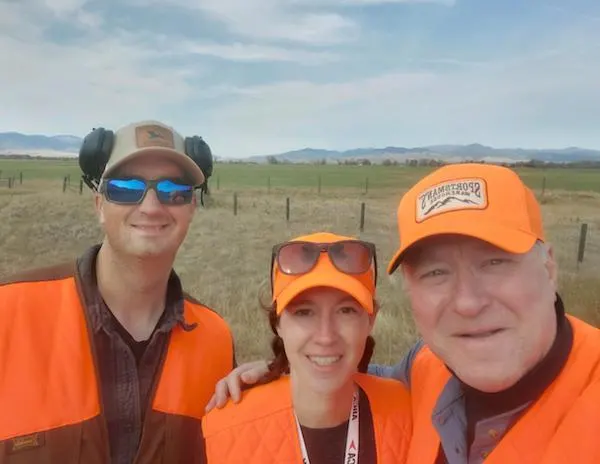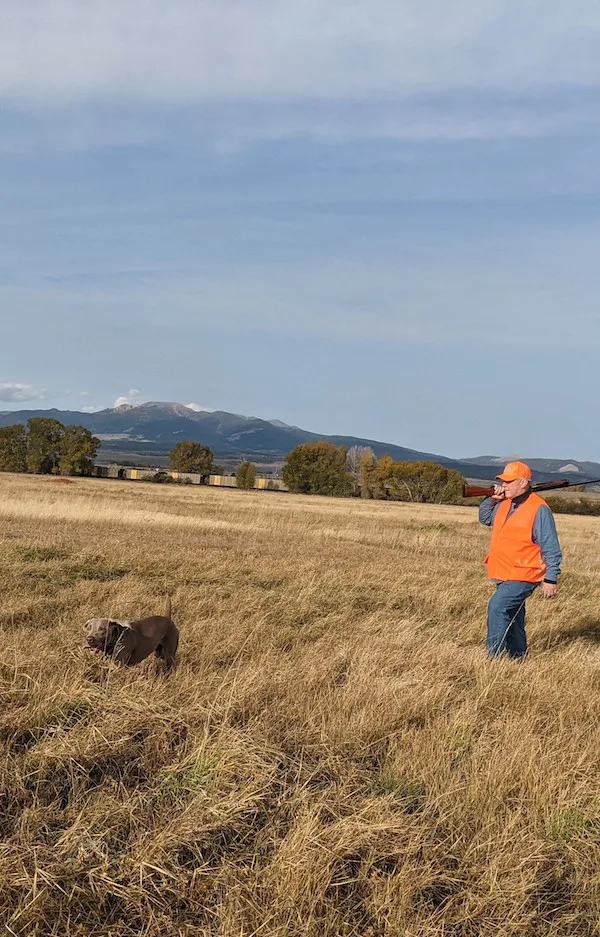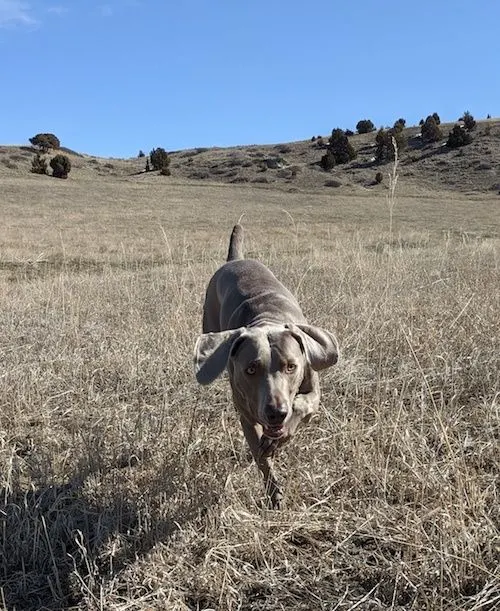I took my 5-year-old weimaraner on his first pheasant hunt this fall. He had never been hunting before (neither had I) and he’s had minimal hunting training.
Yet, he did really well and we had so much fun!
Here are some tips from one newbie and her dog to another. This is a long article, so feel free to skip ahead to a section that interests you.
This post may contain affiliate links. That Mutt may earn money from the companies mentioned in this post.
What dog is used for pheasant hunting?
All of the sporting breeds can make great dogs for pheasant hunting. This includes all of the pointing breeds, spaniels, setters and retrievers. Even poodles were originally bred for hunting, believe it or not.
I personally have a weimaraner and a yellow Labrador. Both can make great dogs for pheasant hunting, although they work in very different ways.
The weim can cover a huge amount of ground effortlessly and is a pointing breed. Labs will stick closer, flushing the birds.
How do you train a puppy to pheasant hunt?
I have a pointing breed, but this article may be helpful for those of you with flushing and retrieving breeds as well.
Start training your hunting dog early!
Even though I did not start training my pointing dog for hunting until he was 4 years old, you should start as soon as you can.
It’s never too late to start, though, as long as the dog has some bird drive and is wanting to work. I’m glad I decided to give it a try with my dog.
Remy is bred for hunting and I don’t think there’s anything that makes him happier than running free in open space using his nose.
For help training your puppy or young dog, I recommend you join a hunting dog club in your area, especially a NAVHDA chapter (North American Versatle Hunting Dog Association). Find a local NAVHDA group here.
Even if you have to get up super early and drive 2-3 hours to the training event, it is worth it, in my opinion. You don’t have to attend every event, even just 1 or 2 events will be helpful to get you started.
It’s difficult for most people to access live birds for training, as well as access to enough open terrain. Joining a training club will take care of that for you and you just show up with your dog.
If there are no training clubs in your area, then try to find a local one-on-one trainer or mentor. Your dog’s breeder might be able to help you find the right trainer. And, some breeders offer training themselves.
For example, I got a Lab puppy recently, and he’s going to spend a few week’s with his breeder for their board and train program.
Training your hunting dog yourself
You can also train your hunting dog yourself, of course, especially if you have access to purchasing live pigeons for training and have a way to house them temporarily.
For me, finding birds for training was nearly impossible, which is why NAVHDA’s training days were so helpful. Read about my NAVHDA experience here.
There are endless books and YouTube videos available on how to train your hunting dog.
For pointing breeds, here are some of my favorite training resources:
- Standing Stone Kennels training videos (YouTube) *By far, the best resource!
- “Training Bird Dogs” (book by Ronnie Smith and Susanna Love)
- Attend a seminar by Ronnie Smith or Rick Smith
- Accidental Bird Dog (blog)
- Bird Dog Fanatics (private Facebook group)
Gun exposure for your hunting dog
Don’t plan your dog’s first pheasant hunt until you are certain how he feels about gunfire. The last thing you want is for him to be terrified.
I recommend you work with a professional trainer to introduce your dog to gunfire if you have never introduced a dog or puppy to guns before.
With our weimaraner, we slowly introduced him to guns several years ago from a distance while he was running and sniffing in an open field. We saw that our dog was not at all fazed by the sound, so we slowly decreased the distance.
This worked out just fine for Remy, who was only interested in running around sniffing. He could care less about the sound of gunfire. (He is afraid of fireworks and thunder, however. And is a big scaredy pants in general. Go figure.)
Bird exposure for your hunting dog
It’s not always possible to introduce your dog to pigeons or game birds, depending on where you live. For me, joining NAVHDA was so helpful because that way I had access to pigeons for training purposes.
You can also purchase pheasant and grouse wings from GunDogSupply.com to at least introduce your dog to a wing and scent. This is not the same as a live bird, but it’s at least something. I bought a few, just to have on hand to show both my dogs.
When should a dog have its first hunt?
How old should a dog be before hunting?
I personally think it’s best to bring your puppy out for his first hunt once he’s about a year old AND been properly introduced to gunfire.
You just have to have such low expectations for a puppy or young dog. And, depending on his age, he might not be conditioned for running several hours. So you might need to plan a shorter trip.
Also, young dogs are so immature and excitable, so your pup might spend more time eating poop, chasing deer scent or bounding around aimlessly through the grass. Don’t worry about it. Just let him have fun.
Some trainers will say to wait until your dog has had a full year of training before you bring him along on a hunt. So by that time he might be closer to 2 years old. He’ll be (slightly) more mentally mature by then and you’ll have less risk of developing bad habits.
It’s really up to you, but the main thing is to have zero expectations for your dog’s first several hunts, regardless of age.
My dog’s first pheasant hunt
I was really nervous about my dog’s first pheasant hunt. I was worried my dog would just take off, running around like a nutcase, not paying any attention to me. I was also worried he would grab a bird and take off. (He didn’t do either of those things.)
In our case, it really helped me to go hunting with my Dad, who has a lot of hunting experience. My husband Josh came along too.
We hunted at a local game farm where they place birds out for you. That way, you’re pretty much guaranteed to see some birds. This is helpful when you’re trying to train your dog and just gain experience and make it fun.
The game farm we chose was very helpful and understanding that this was my dog’s very first hunt ever. The owner placed a rooster a few yards out for us right away, just so my dog would be able to find it and understand what he was supposed to do.
Well, my dog knew exactly what he was supposed to do and found that bird immediately!
I had him on his check cord so I could prevent him from grabbing or chasing the bird. I held him back while I flushed it, my dad shot it and then I released Remy to retrieve. He did a great job!
As soon as we did that, all my anxiety went away because I saw that my dog’s natural instincts and basic training had clicked and he knew what he was supposed to be doing.
Yes, he needs some serious work on holding his point, but I’m just glad he is great at using his nose.
Remy found about 6 birds
We spent the next 3.5 hours or so hunting for the pen-raised and wild pheasants throughout various fields and cover. My dad and Josh were doing the shooting and I was just handling and training Remy.
I had him on his check cord for the first half-hour or so while he burned off his initial energy. I didn’t want him to charge the birds he found.
After, that, I removed the check cord but kept him on his Garmin e-collar.
Remy did a nice job working close to us. He seemed to have some understanding that we were working as a team and it wasn’t all about him.
I didn’t need to use the collar much to call him back. It also has a GPS on it for safety. He did run into some heavy cattails for awhile and we couldn’t see him so the GPS gave me some peace of mind.
Read my review of the Garmin Alpha here.
Remy ended up finding about 5 or 6 more birds throughout the day. A few got away from us, but we ended up with two hens and two roosters overall, so we took that as a win.
We walked 4 miles, according to my GPS watch and Remy ran 8 miles according to his Garmin. It was not a hot day, which helped my dog (and us). I carried water for him and he had no issues with overheating. He’s in perfect condition.
Dog for tracking wounded game
I was especially proud of my dog when one of the hens took off running after she was shot. She headed for some very thick cover and there was absolutely no way we could’ve found her without our dog.
Remy was really struggling to find her as well. We searched for quite awhile and seemed like we were never going to find her.
Just as we were ready to give up and started to walk away, Remy found her and caught her! This was the best part of the day for me because no one wants to waste a bird or leave a wounded bird behind to suffer.
This reinforced what I already knew but had never experienced. A dog is a very valuable tool for hunting. There’s no way we would’ve found as many birds without our dog. And, we never would’ve found that wounded bird without Remy. Good boy.
Your dog’s first pheasant hunt
In my very limited experience, here are my suggestions for your dog’s first pheasant hunt, regardless of breed. Take this for what it’s worth as I am no expert.
1. Have a plan.
Your plan might have to change, but at least have somewhat of a “game plan” in mind beforehand and communicate that with everyone you’re with.
For example, I knew I didn’t want to carry a gun so I could focus on my dog. I also knew I wanted to keep him on his check cord at first so I could hold him on point. After that, I wanted to try to just let him run and do his thing. Our plan ended up working out perfectly.
My dog and I both gained a lot of confidence that day and now I know what we need to work on (holding his point & cleaner retrieves).
2. Low expectations and have fun!
I had anxiety about how my dog’s first pheasant hunt would go. Everyone wants their dog to do well.
But … remember, your dog is doing his best and the main thing is you are spending time with your dog, family and friends.
These are memories you will have forever and will look back on someday and wonder why you even cared if your dog listened perfectly or how many birds you found.
I’m so thankful for my dog and because of him I got to spend the day hunting with my dad, something we would not have planned if I didn’t have Remy. I’m sure we’ll go hunting again, but the first hunt will always be special.
3. Go to a preserve or game farm.
This is not a requirement, but I found this so helpful because the farm released several birds for us, almost guaranteeing we would find several. (It’s still not easy!)
This was a great way to boost my dog’s confidence and have several opportunities to build on his training. I would like to go back to the game farm several times before we hunt on public land.
4. Go with someone who knows what they’re doing.
It was helpful to go hunting with my dad and my husband. Both are very comfortable with guns and my dad has been hunting all his life. That way, they were able to focus on shooting while I just walked and handled my dog.
My dad was also able to clean the pheasants for us afterwards and cook us an amazing pheasant dinner! Also a win.
Potential problems on your dog’s first pheasant hunt
1. The dog doesn’t understand what to do.
My weimaraner seems to have a lot of natural instincts and big drive for finding birds. His parents and grandparents were all field dogs, so its in his genes. The minimal training we did through NAVHDA and attending a Rick Smith seminar helped bring out these natural instincts.
If your dog doesn’t seem to understand he’s supposed to be looking for birds, that’s OK. He might think you’re just out for a fun hike, so go with it and enjoy the day with your dog.
Hopefully, he’ll naturally catch scent of some birds or accidentally flush some up. This is why a game farm is so helpful because there’s generally more birds to “stumble upon.”
2. The dog runs way too far ahead.
I know that my dog can have a big range and big comfort zone, so I kept him on his 30-ft check cord to prevent him from charging/flushing up birds waaay too far ahead of us. (A big range is great if your pointing dog has a solid, steady point. Mine does not!)
At least one trainer told me to just let my dog run a big range, and if he pressures the birds too far from us, the birds will get away. This will teach my dog that he needs to work closer to us, as a team, if he wants to get any birds.
I prefer the check cord approach with my particular dog. That way, once he found a bird, I could just hold him on point, flush the bird myself and then release him for the retrieve. This allowed us, as beginners, to get a lot of basic experience.
3. The dog is overheating.
Hunt in the morning vs. afternoon, if you can. Try to go on a cool, cloudy day. Have at least 2 gallons of water for your dog at the truck and a way to carry water for your dog while you’re hunting, as well.
I carried a small water bottle and a small collapsible bowl for my dog in my vest pockets.
Most of these dogs will not stop on their own, unless they are about ready to collapse. So, you have to be an advocate for your dog and make him take breaks, as needed.
4. He runs off with the bird.
If this happens, you just have to go with it and plan to work on it in the future. Not much you can do in the moment. Put your dog on a check cord to prevent him from running off, for now. Praise him when he does finally drop the bird.
5. Your pointing dog doesn’t point.
My dog certainly doesn’t hold his point, so I’m with you. Most young dogs or beginning dogs will try to charge or creep up on the birds. That’s why I chose to go with the check cord at first.
Developing steadiness takes lots of repetition and a solid training plan over a couple of seasons. It’s not going to be natural for most dogs.
6. The dog is afraid of gunfire.
I’m no expert here, but if your dog is afraid of the guns, I would probably stop shooting for the day and just walk the fields and let him run around. Not ideal, I know. Then, come up with a training plan for the future or work with a professional.
If he’s only slightly nervous and you think he’ll be OK, you could try letting him run for a 20-mins or so and then shoot while he’s having fun and distracted by scent.
If you’re at a game farm and they will release a bird right in front of your dog while you shoot, that would be ideal. That way, he’ll be focused on chasing the bird vs. the sound of the gun.
Important commands to teach your hunting dog
My dog is not a very obedient dog, I’ll be honest. But for hunting purposes, the most important commands to work on with him are:
- Come! (with and without e-collar)
- Fetch!
- Hunt’m Up! (Find It)
Heel and stay are also very important but my dog does not heel when he’s amped up and I step on his check cord when I really need him to stay put.
Teaching “woah” (stop and hold point) is also obviously important for pointing dogs and something we need to work on. But it’s not necessary for those first few hunts.
Training tools and supplies for your hunting dog
- 6-ft leather leash + buckle collar
- 30-ft check cord and gloves
- E-collar with GPS
- Lots of water!
- A way to carry water for your dog during the hunt (not just back at the truck)
- Collapsible dog bowl
Other supplies to consider:
- Chain slip collar for training
- Dog first aid kit
- Crate or stake-out
- Orange visibility vest
- Skid plate/chest protector
What helped me the most on my dog’s first pheasant hunt:
- Attending NAVHDA training days. These paid off a lot more than I realized.
- Attending a Rick Smith introductory seminar.
- Watching lots of Standing Stone Kennels YouTube videos
- Going to a low-key game farm for our first hunt
- Hunting with someone who knows what they’re doing.
Next steps for my hunting dog
My weimaraner and I are still beginners and I don’t expect him to ever be a “finished” bird dog. And that is OK. We got a late start, and we’re just out there to have fun.
Still, I do want to try to improve on our skills, so here is what I plan to work on slowly but surely:
1. Introduce “woah” and getting him to hold his point. I know this just comes with repetition. So, I can only expect so much when we only get out there a few times a year.
2. Improve on recall and moving with me with and without the e-collar.
3. Reinforce a closer range. He did well with this.
4. Cleaner retrieves. I was glad he did not run off with the bird, but I usually had to walk over and get the bird from him.
5. Improve my comfort level with guns. I need to get out to the range regularly and practice shooting without my dog around and just build on my skills and comfort level.
Do you have a hunting dog? In the comments, let me know what tips you have for a dog’s first pheasant hunt!
-Lindsay & Remy
Related articles:
- What to expect at your first NAVHDA training day
- Ultramarathon training with my dog
- What to do when your dog is obsessed with fetch
Get all of our training tips HERE.

